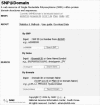SNP@Domain: a web resource of single nucleotide polymorphisms (SNPs) within protein domain structures and sequences
- PMID: 16845090
- PMCID: PMC1538855
- DOI: 10.1093/nar/gkl323
SNP@Domain: a web resource of single nucleotide polymorphisms (SNPs) within protein domain structures and sequences
Abstract
The single nucleotide polymorphisms (SNPs) in conserved protein regions have been thought to be strong candidates that alter protein functions. Thus, we have developed SNP@Domain, a web resource, to identify SNPs within human protein domains. We annotated SNPs from dbSNP with protein structure-based as well as sequence-based domains: (i) structure-based using SCOP and (ii) sequence-based using Pfam to avoid conflicts from two domain assignment methodologies. Users can investigate SNPs within protein domains with 2D and 3D maps. We expect this visual annotation of SNPs within protein domains will help scientists select and interpret SNPs associated with diseases. A web interface for the SNP@Domain is freely available at http://snpnavigator.net/ and from http://bioportal.net/.
Figures


Similar articles
-
SNP mining porcine ESTs with MAVIANT, a novel tool for SNP evaluation and annotation.Bioinformatics. 2007 Jul 1;23(13):i387-91. doi: 10.1093/bioinformatics/btm192. Bioinformatics. 2007. PMID: 17646321
-
MyHits: a new interactive resource for protein annotation and domain identification.Nucleic Acids Res. 2004 Jul 1;32(Web Server issue):W332-5. doi: 10.1093/nar/gkh479. Nucleic Acids Res. 2004. PMID: 15215405 Free PMC article.
-
LS-SNP: large-scale annotation of coding non-synonymous SNPs based on multiple information sources.Bioinformatics. 2005 Jun 15;21(12):2814-20. doi: 10.1093/bioinformatics/bti442. Epub 2005 Apr 12. Bioinformatics. 2005. PMID: 15827081
-
New in protein structure and function annotation: hotspots, single nucleotide polymorphisms and the 'Deep Web'.Curr Opin Drug Discov Devel. 2009 May;12(3):408-19. Curr Opin Drug Discov Devel. 2009. PMID: 19396742 Review.
-
Cytokine gene polymorphism in human disease: on-line databases, Supplement 3.Genes Immun. 2006 Jun;7(4):269-76. doi: 10.1038/sj.gene.6364301. Epub 2006 Apr 27. Genes Immun. 2006. PMID: 16642032 Review.
Cited by
-
SNP@Promoter: a database of human SNPs (single nucleotide polymorphisms) within the putative promoter regions.BMC Bioinformatics. 2008;9 Suppl 1(Suppl 1):S2. doi: 10.1186/1471-2105-9-S1-S2. BMC Bioinformatics. 2008. PMID: 18315851 Free PMC article.
-
Meet me halfway: when genomics meets structural bioinformatics.J Cardiovasc Transl Res. 2011 Jun;4(3):281-303. doi: 10.1007/s12265-011-9259-1. Epub 2011 Feb 25. J Cardiovasc Transl Res. 2011. PMID: 21350909
-
Structure SNP (StSNP): a web server for mapping and modeling nsSNPs on protein structures with linkage to metabolic pathways.Nucleic Acids Res. 2007 Jul;35(Web Server issue):W384-92. doi: 10.1093/nar/gkm232. Epub 2007 May 30. Nucleic Acids Res. 2007. PMID: 17537826 Free PMC article.
-
An integrated database-pipeline system for studying single nucleotide polymorphisms and diseases.BMC Bioinformatics. 2008 Dec 12;9 Suppl 12(Suppl 12):S19. doi: 10.1186/1471-2105-9-S12-S19. BMC Bioinformatics. 2008. PMID: 19091018 Free PMC article.
-
Towards precision medicine: advances in computational approaches for the analysis of human variants.J Mol Biol. 2013 Nov 1;425(21):4047-63. doi: 10.1016/j.jmb.2013.08.008. Epub 2013 Aug 17. J Mol Biol. 2013. PMID: 23962656 Free PMC article. Review.
References
Publication types
MeSH terms
LinkOut - more resources
Full Text Sources
Molecular Biology Databases

